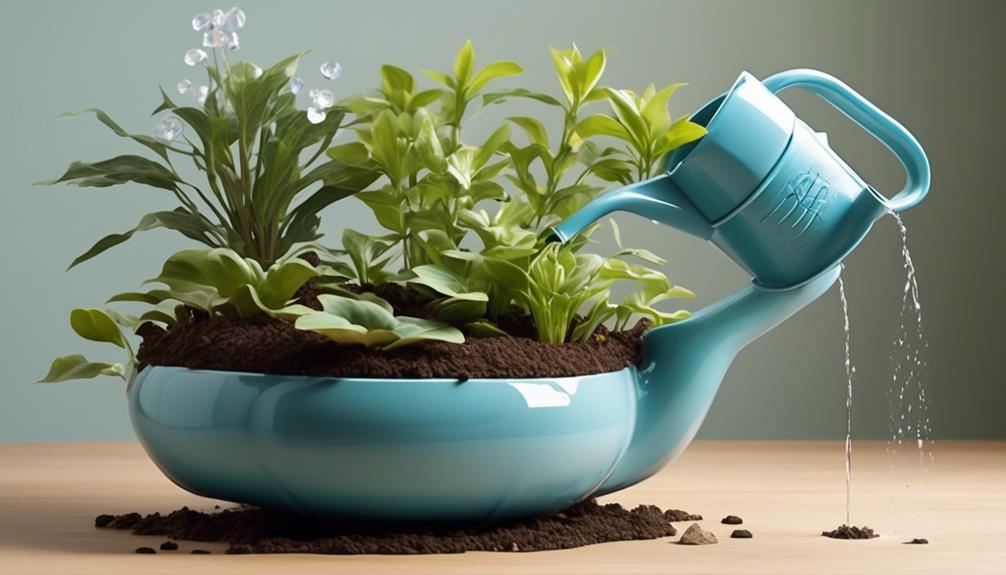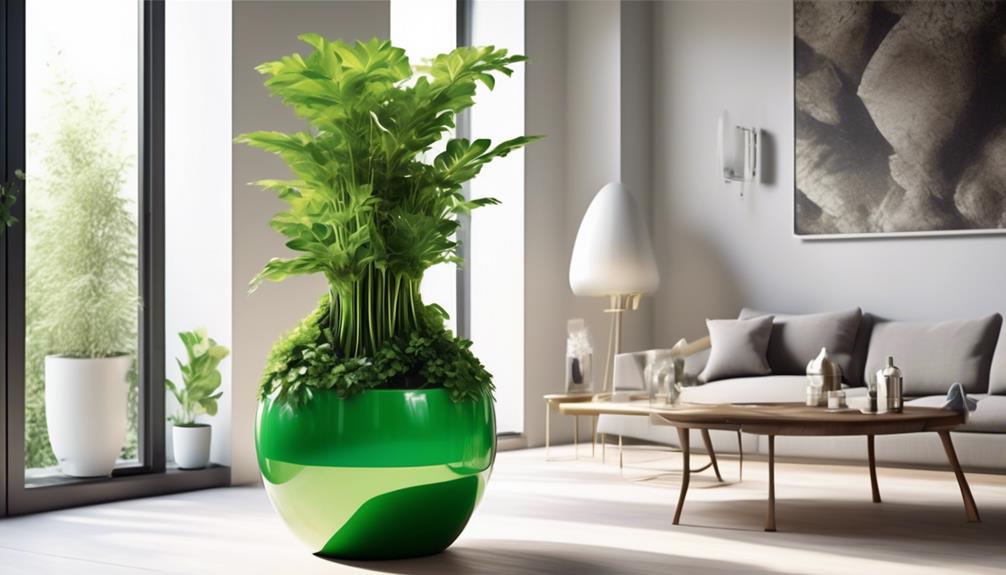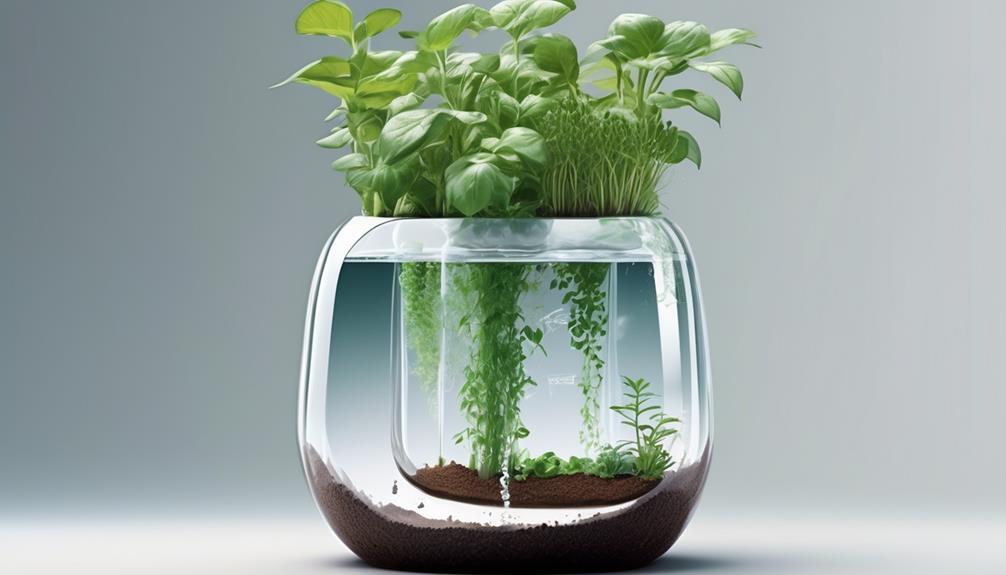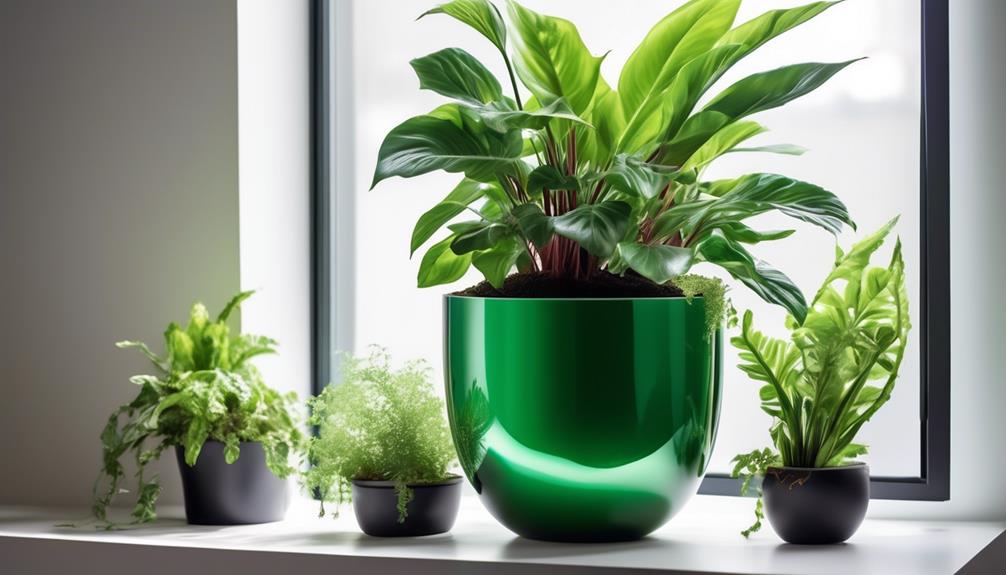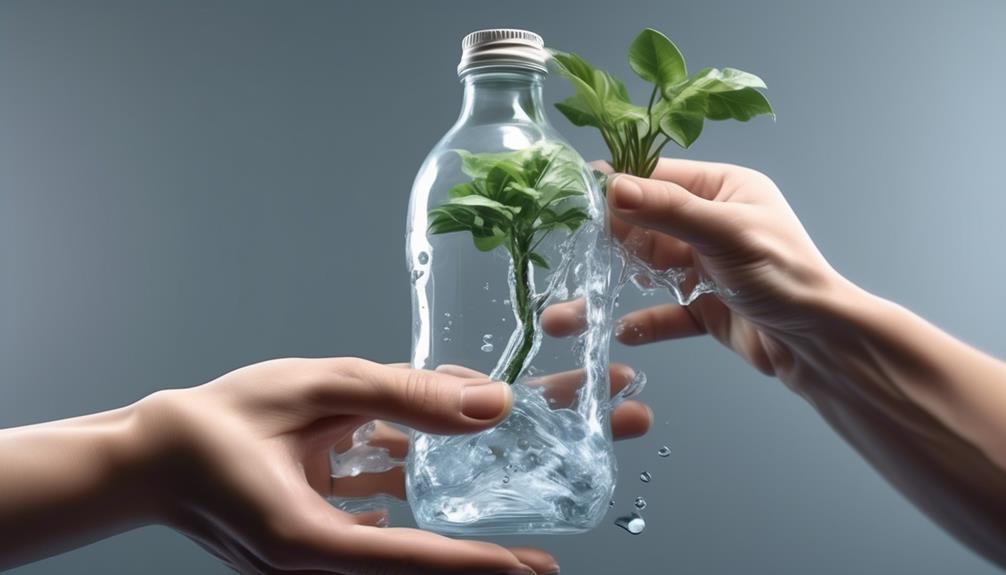You have chosen to improve the living conditions of your plant friends with self-watering pots. But how can you pamper them without turning your home into a swamp?
Well, we've got just the tips you need to keep your plants thriving while you sit back and relax. From choosing the right potting mix to setting up the self-watering system, we'll guide you through the ins and outs of plant spa self-watering pots.
So, let's ensure your plants are hydrated and flourishing, all while you enjoy a little less time worrying about their care.
Key Takeaways
- Self-watering pots significantly reduce manual watering frequency
- Choosing the right potting mix is important for optimal plant growth
- Setting up the self-watering system properly promotes consistent watering and healthy root development
- Monitoring and adjusting water levels based on plant's needs and environmental conditions is crucial.
Benefits of Self-Watering Pots
Using self-watering pots can significantly reduce the frequency of manual watering and help maintain consistent soil moisture levels for optimal plant growth. These pots work by using a reservoir system that allows the plant to draw water up through the soil as needed. This means less time and effort spent on watering, making it an ideal solution for busy individuals or those who may struggle with regular watering schedules.
By regulating the watering frequency, self-watering pots create an environment where plants can thrive. Consistent moisture levels are crucial for the overall health and growth of plants. When the soil is too dry, it can stunt growth and cause stress to the plant. On the other hand, overwatering can lead to root rot and other issues.
With self-watering pots, the risk of overwatering or underwatering is minimized, providing an optimal growing environment for plants.
Choosing the Right Potting Mix
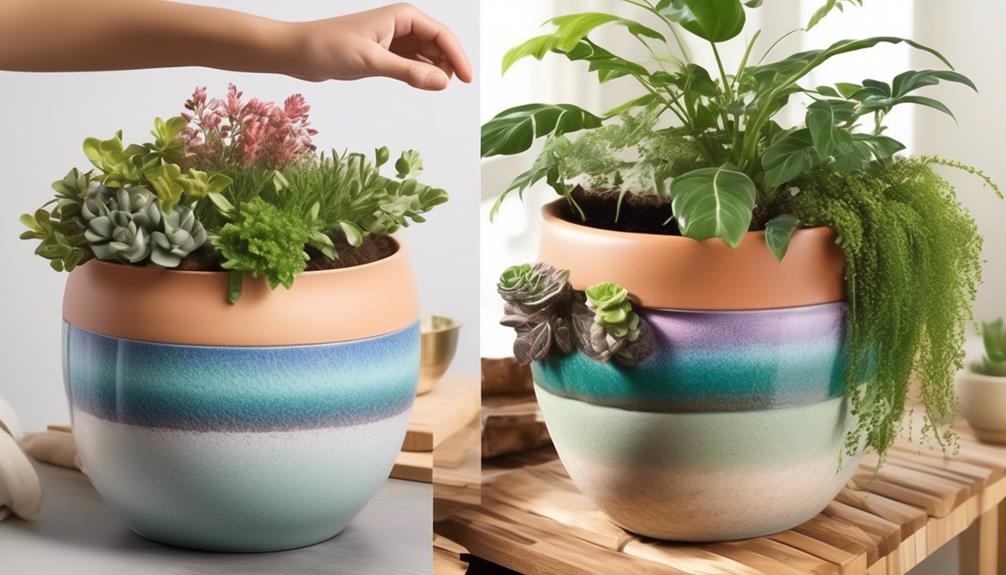
When selecting a potting mix for self-watering pots, it is essential to consider the water retention capacity and nutrient content of the medium to support healthy plant growth. The potting mix plays a crucial role in the overall success of self-watering pots, as it directly impacts the watering frequency and nutrient requirements of the plants. Here, we'll delve into the key factors to consider when choosing the right potting mix for your self-watering pots.
| Key Factors | Description | Example |
|---|---|---|
| Water Retention Capacity | The ability of the potting mix to hold water for a prolonged period, reducing the frequency of watering. | Peat moss, coconut coir |
| Nutrient Content | The presence of essential nutrients to support plant growth and development. | Perlite, vermiculite, compost |
| Aeration | The level of air circulation within the potting mix, ensuring the roots receive sufficient oxygen. | Perlite, coarse sand |
Selecting a potting mix with optimal water retention capacity, nutrient content, and aeration is vital for maintaining the health and vigor of plants in self-watering pots. By considering these factors, you can provide an environment that supports healthy plant growth while reducing the watering frequency and meeting the nutrient requirements.
Setting Up the Self-Watering System
To set up the self-watering system, it's advisable to carefully position the water reservoir and wick within the pot to ensure optimal water distribution to the plant's roots. Here are the steps to set up the self-watering system:
- Watering Frequency: Place the water reservoir in a position that allows easy access for refilling while ensuring it's stable and secure to prevent any accidental spillage.
- Root Health: Position the wick so that it reaches the bottom of the pot and makes contact with the water reservoir. This will facilitate the capillary action, allowing water to be drawn up to the plant's roots as needed.
- Check Wick: Ensure the wick is clean and unobstructed to maintain an effective water supply to the plant. Trim the wick if it becomes too long, as it may hinder proper water uptake.
- Monitor Moisture: After setting up the system, monitor the soil moisture regularly to gauge the watering frequency needed for your specific plant. Adjust the water level in the reservoir according to the plant's requirements to support optimal root health.
Setting up the self-watering system in this manner ensures consistent watering and promotes healthy root development, ultimately contributing to the overall well-being of the plant.
Monitoring and Adjusting Water Levels
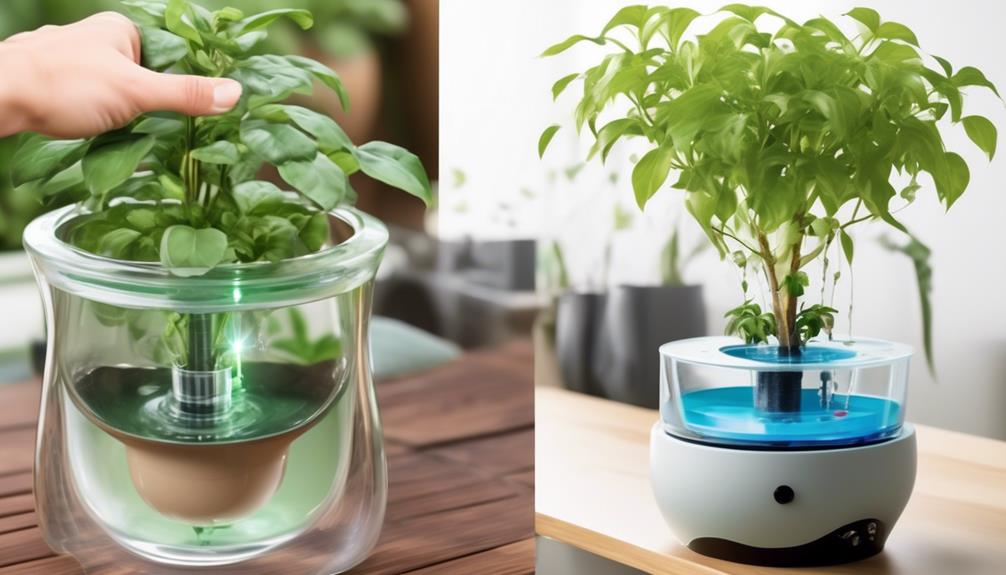
We recommend regularly monitoring the water levels in the reservoir and adjusting them as necessary to ensure consistent and adequate hydration for the plant.
Proper monitoring includes checking the water level at least once a week, or more frequently during hot and dry weather conditions.
The watering frequency will depend on the plant's needs and the environmental conditions. It's important to remember that different plants have different water requirements, so be sure to check the specific needs of your plant.
To monitor the water levels, it's essential to check the soil moisture as well. Inserting a moisture meter into the soil can provide an accurate reading of how much water the plant has used and whether the reservoir needs refilling. Additionally, visually inspecting the soil for dryness can also help determine if the water level needs adjusting.
Adjusting the water levels in the reservoir should be done gradually and based on the plant's water needs.
Tips for Successful Plant Care
In successful plant care, regular and thorough observation of the plant's growth and overall health is crucial for identifying any potential issues early on. Here are some essential tips for successful plant care:
- Proper sunlight: Ensure that your plants receive the appropriate amount of sunlight based on their specific needs. Monitor the sunlight exposure and adjust the plant's location accordingly to prevent overexposure or underexposure.
- Humidity control: It's important to maintain the right level of humidity for your plants. Use a hygrometer to measure the humidity levels in the air and consider using a humidifier or a pebble tray to adjust the humidity as needed.
- Regular watering: Establish a consistent watering schedule based on the specific requirements of each plant. Monitor the soil moisture regularly and adjust the watering frequency as necessary to prevent overwatering or underwatering.
- Nutrient management: Provide the appropriate nutrients to your plants through fertilization. Monitor the plant's growth and health to determine the right type and frequency of fertilization needed for optimal growth and development.
Frequently Asked Questions
Can Self-Watering Pots Be Used for All Types of Plants, Including Succulents and Cacti?
Yes, self-watering pots can be used for a variety of plants, including succulents and cacti. The benefits include consistent moisture levels and reduced watering frequency.
However, they may not be suitable for plants that prefer dry conditions or are prone to root rot. It's important to consider the specific needs of each plant before choosing a self-watering pot.
Are Self-Watering Pots Safe to Use Indoors, or Are There Any Potential Water Leakage Issues?
Self-watering pots are safe for indoor use. We ensure no water leakage issues through our design and rigorous testing.
Potential maintenance is minimal, requiring occasional top-ups of the water reservoir. Watering frequency is reduced as the plant draws water as needed.
Our system maintains optimal moisture levels, preventing overwatering or underwatering. It's a reliable, hassle-free solution for indoor plants, providing peace of mind and healthy, thriving greenery.
What Are the Best Practices for Cleaning and Maintaining Self-Watering Pots to Prevent Mold or Bacteria Growth?
Cleaning and maintaining self-watering pots is crucial to prevent mold and bacteria growth. To keep them spick and span, we recommend using a mild soap and water solution to clean the reservoir and inner pot. Ensure proper ventilation to prevent moisture buildup.
Adjust the watering frequency based on plant needs and pot size. Self-watering pots are effective, but regular maintenance is key to ensuring healthy plant growth and preventing mold.
Can Self-Watering Pots Be Left Unattended for Extended Periods of Time, Such as During Vacations?
Yes, self-watering pots can be left unattended for extended periods, such as during vacations.
The self-watering technology provides benefits for vacation care, as it ensures consistent moisture levels for the plants.
Troubleshooting tips for extended absences include checking water levels before leaving, using a larger reservoir, and placing the pots in a shaded area.
These measures help maintain the plants' health and hydration while you're away.
Are There Any Specific Plants or Flowers That Should Not Be Grown in Self-Watering Pots Due to Their Specific Water Needs?
Absolutely!
When it comes to plant compatibility with self-watering pots, it's crucial to consider their specific water needs. Some plants, like succulents and cacti, may not thrive in self-watering pots due to their lower water requirements.
Conversely, water-loving plants such as ferns and peace lilies are excellent choices.
It's important to research the water requirements of individual plants to ensure they're suitable for self-watering pots.
Is the Plant Spa Self Watering Pot Different from Other Self Watering Plant Pots?
Yes, the Plant Spa Self Watering Pot offers a unique approach to self watering plant pots usage compared to other products in the market. Its innovative design ensures proper hydration for your plants without the need for constant monitoring or frequent refills.
Conclusion
In conclusion, self-watering pots offer a convenient way to ensure our plants receive the right amount of water, reducing the risk of over or under-watering.
Did you know that self-watering pots can reduce water usage by up to 80% compared to traditional watering methods?
This means less time spent watering and more time enjoying healthy, thriving plants.
With the right potting mix and proper monitoring, self-watering pots can be a game changer for plant care.

